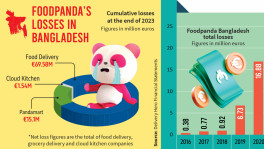Bangla Bari: Building sustainable structures for our rural Bangladesh
The firm ‘Bangla Bari’ provides affordable, sustainable architectural solutions for rural areas across Bangladesh

Sanaullah Mia is a rickshaw puller from Kurigram. A small tin house of 119 square metres is all he has.
Six members of his family live here. They endure the scorching heat during summer and the shivering cold of North Bengal during winter.
But within this small space, an exceptional group of architects from the firm 'Bangla Bari' have built a unique living place.
Costing only Tk4,00,000, this house has two living rooms, kitchen, washing area, toilet, cattle shed, storage area and even a courtyard.
Hybrid blocks made by inserting soil and lime in the cement have been used to build the house instead of regular bricks that are harmful to the environment.

The environmentally-friendly bricks are naturally insulated, protecting the residents from extreme heat and cold.
Instead of using CI sheets or tin, tin made from jute has been used for the house.
An ideal structure for rural areas
While the world is applauding eco-friendly, vernacular designs, Bangladesh is still promoting urban-centred architecture.
The founder of Bangla Bari Fawaz Rob said, "Our goal is to create an eco-friendly and sustainable design for building houses. Our firm operates outside the City Corporation areas."
He said that they undertake rapid building, which means it takes them less than four months to build a 4,500 square foot two-storey house.
They also act as a third party construction company so they look after things such as getting house building permits, doing electrical and mechanical work and plumbing.
A few notable works by Bangla Bari include the Amirabad Clinic made of bamboo and jute in Faridpur, Jaago School in Dinajpur, a library in Teknaf and the Safe Water and Sanitation Project with the Rural Development and Cooperative division.

Under the sanitation project, the firm has built 112 latrines in four months.
Bangla Bari is also working with the United Nations Development Program (UNDP) to create a modular-based sanitation system. This project is still a prototype.
But once this sanitation system is implemented, latrine installation time will be reduced by 60% and the cost will be halved.
This project has the potential to ensure safe sanitation in remote areas and refugee camps around the world.
In addition to UNDP, Bangla Bari has worked with UN-Habitat, Japan International Cooperation System and Japan International Cooperation Agency.
Bangla Bari has also been featured by Nikkei Japan, Al-Jazeera and the Commonwealth Association of Architects.

The beginning
After finishing his studies from Faujdarhat Cadet College, Rob went to the United States to study product design at San Francisco State University.
He then earned a higher degree in architecture from an Italian institute.
After a long tour of various European countries, he returned home and began teaching at the Department of Architecture at North South University.
While teaching, he noticed that with time, although the world was moving forward, the study of architecture in Bangladesh was still stuck with the old American curriculum of the 1970s and 1980s.

Soon he started visiting different rural areas and this experience inspired him to start working for the country's marginalised groups.
In Bangladesh, only a few architects work on rural architecture whereas more than 60% of the population live outside cities.
Fawaz Rob's desire to work for rural communities in the country gave birth to Bangla Bari.
For a greener future
The United Nations Environment Program and the Climate and Clean Air Coalition, signatories of which are the US, Canada, Sweden, Mexico, Bangladesh and Ghana, say brick kilns are the biggest irreversible source of black carbon emissions.
About 20% of black carbon emissions come from brick kilns.
According to the 2021 Air Quality Index (AQI), Dhaka was the second most polluted city globally.
Bangladesh's average AQI score was 159. If the AQI score of an area is between 101 and 150, its residents - especially the children, elderly and the sick - are likely to be at risk of health damage.
According to the Climate and Clean Air Coalition, brick kilns account for 30% to 50% of PM2.5 emissions in the air during the dry season in Bangladesh.
PM2.5 is a type of solid or aqueous ultrafine particle that is so delicate that it easily enters the lungs with inhalation. Then it spreads all over the body.
From a seemingly harmless sneeze and cough, these particles can lead to diseases ranging from shortness of breath to complex diseases like cancer, heart attack and chronic bronchitis.
These particles are one of the primary causes of cancer in the human body.
According to the latest Air Quality Life Index published by the Energy Policy Institute of the University of Chicago in September 2021, the average life expectancy of the people of Bangladesh has decreased by about five years and four months due to air pollution.
In Dhaka, the average life expectancy has decreased by a staggering seven years and seven months.
About 15.6 million tons of carbon dioxide are being added to the atmosphere every year from brick kilns.

There are more than 7,000 brickfields in the country. According to 2016 estimates, more than 23 billion bricks are produced annually.
On this aspect of environmental pollution, Fawaz said, "Building houses with local and traditional materials along with earth bricks and cement bricks will not only reduce the cost but also reduce pollution."
He added that local materials are also quite durable. As an example, he mentioned a test conducted in the laboratory of a Peruvian university.
During that test, it was observed that as soon as the Richter scale crossed 4 during an earthquake, the brick structure began to crack.
The same house was then built with CSEB (Compressed Stabilised Earth Blocks; also known as pressed earth blocks).
This time, even after crossing 8 on the Richter scale, the structure did not crack.
"These houses do not have any RCC (Reinforced Cement Concrete) columns. The whole structure is not hollow and there are many columns spread all over like a net," he explained about the structure's strength.
A sense of entitlement
Bangla Bari's goal is not just to build an environmentally friendly, sustainable house. In each project, they want to ensure that the people who reside in the house are involved with the construction process.
"At least one person from the family stays with us all the time. S/he watches what is happening and shares their needs. Since the family members are involved with the whole process, they feel a sense of entitlement," Rob said.

The residents' opinion is also taken into account before building a house. For example, Sanaullah said he needed a small barn and his wife needed a small storage room.
As a result, the Bangla Bari team designed the house considering all these needs.
As Kurigram is a flood-prone area, the house's structure has been supported a few feet above the ground.
"His house will not sink in the next 10 rainy seasons. We have also reduced pollution during brick constructions. This is where our success lies," Rob informed us.


 Keep updated, follow The Business Standard's Google news channel
Keep updated, follow The Business Standard's Google news channel
















